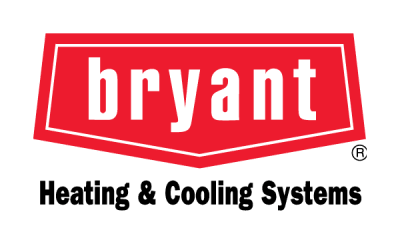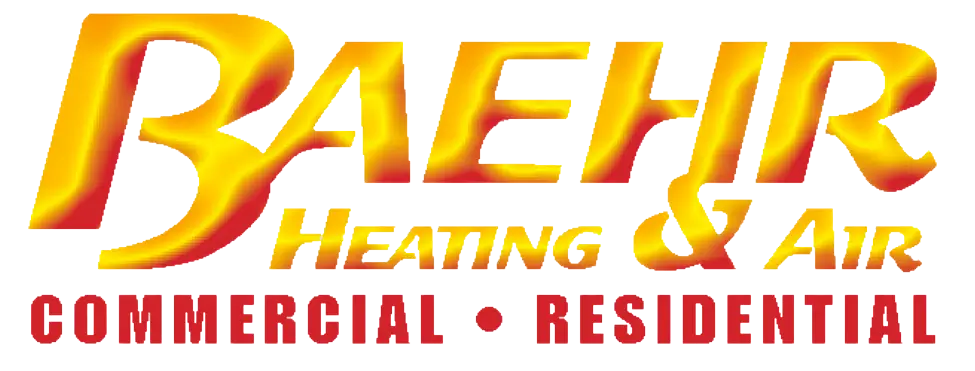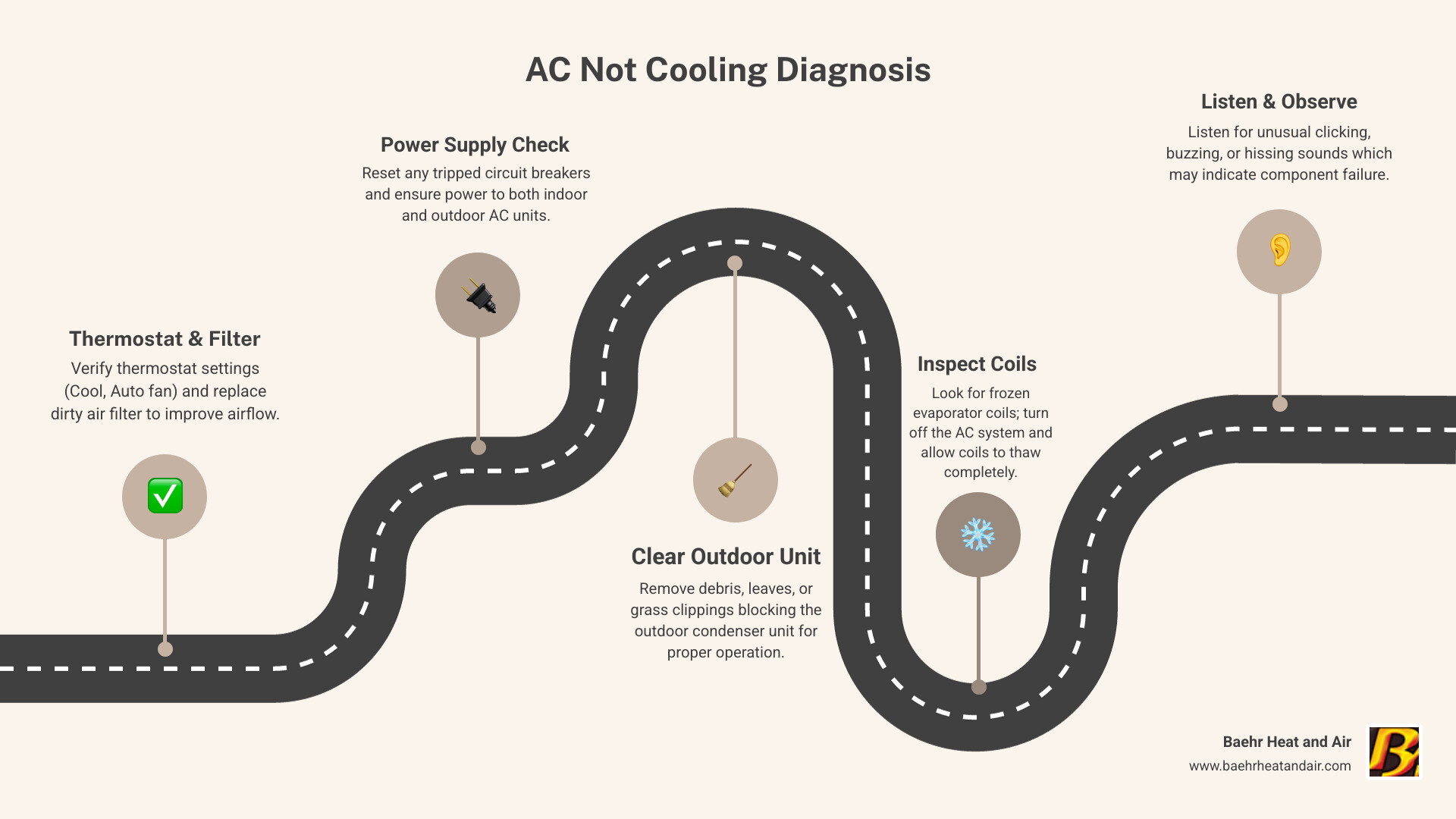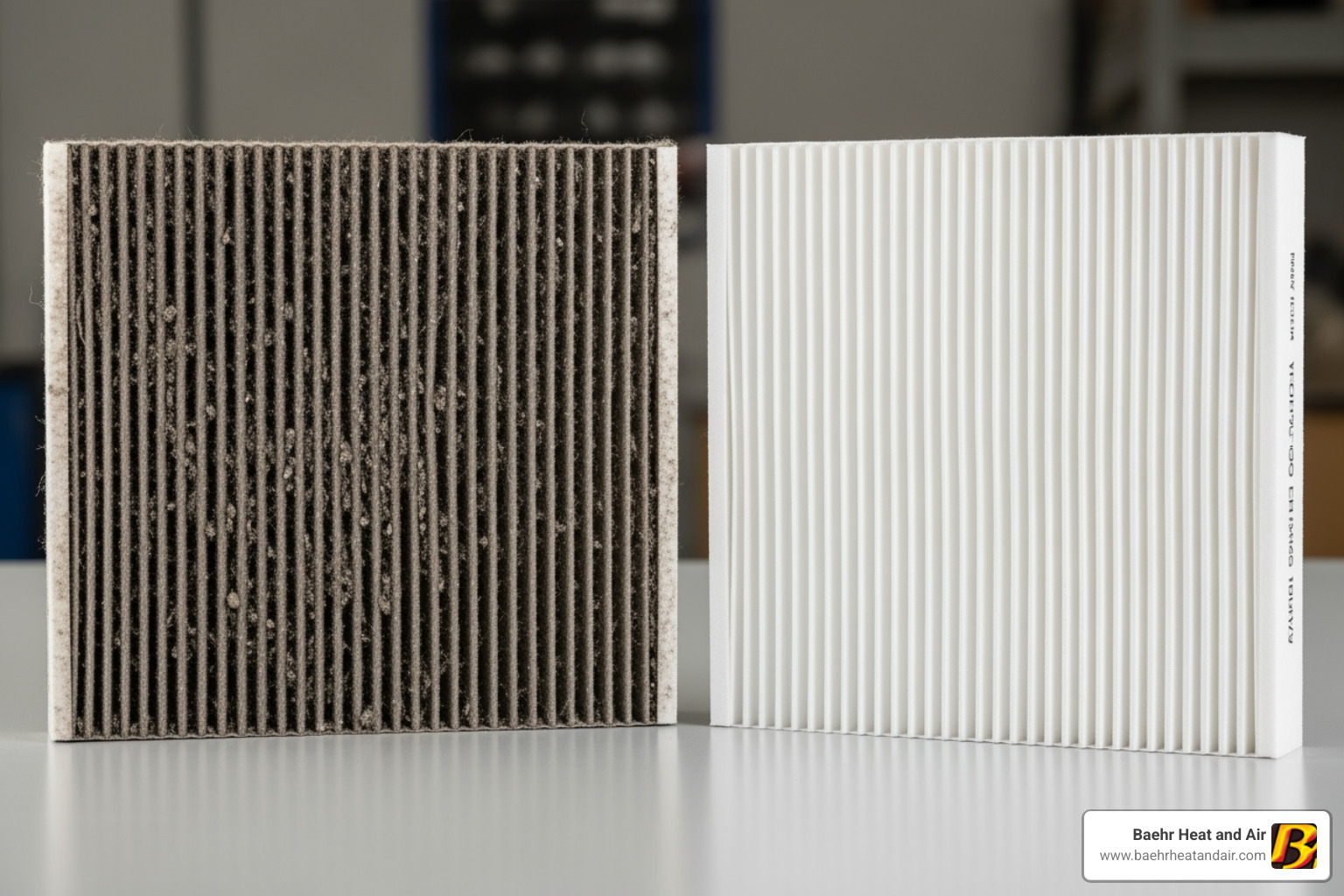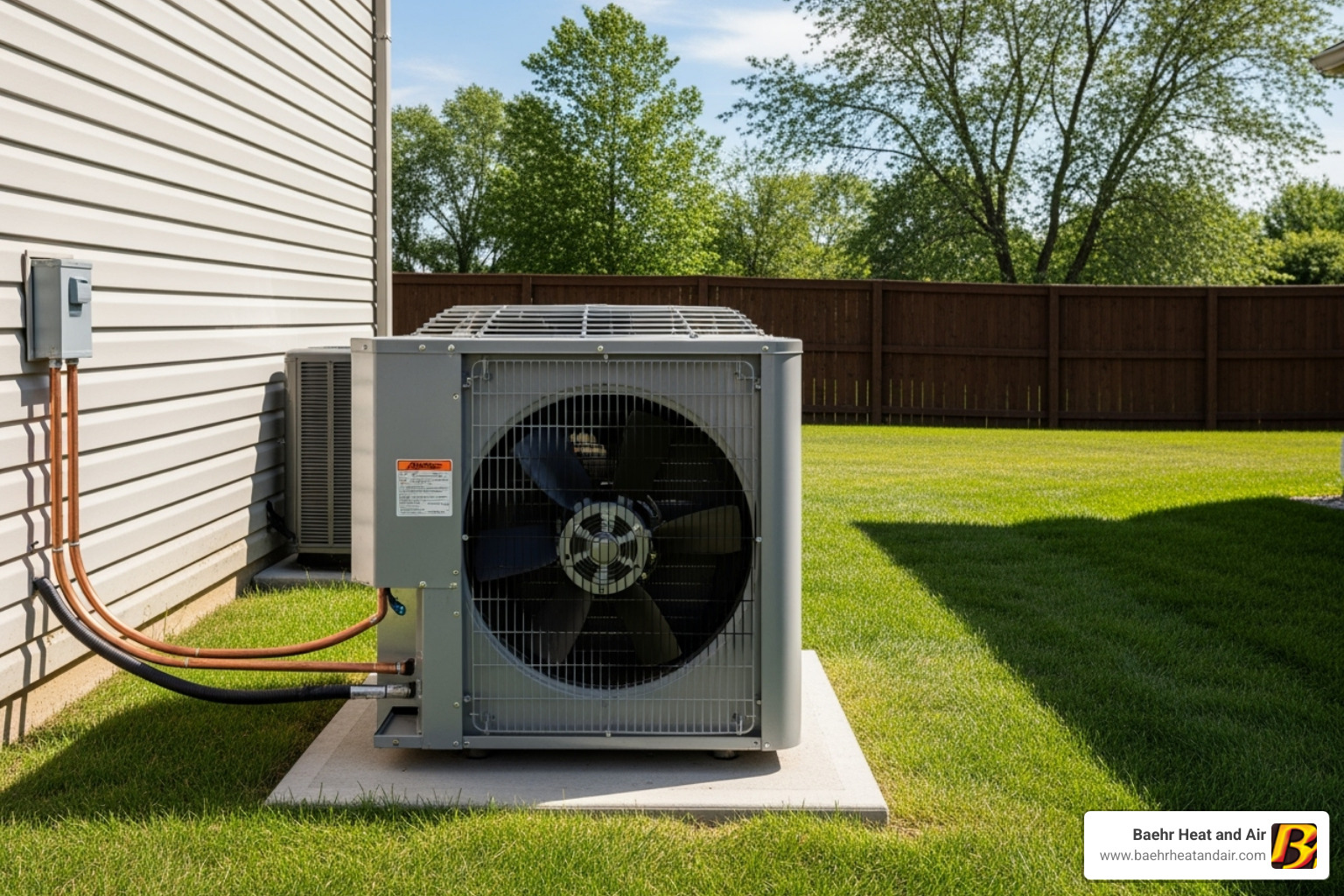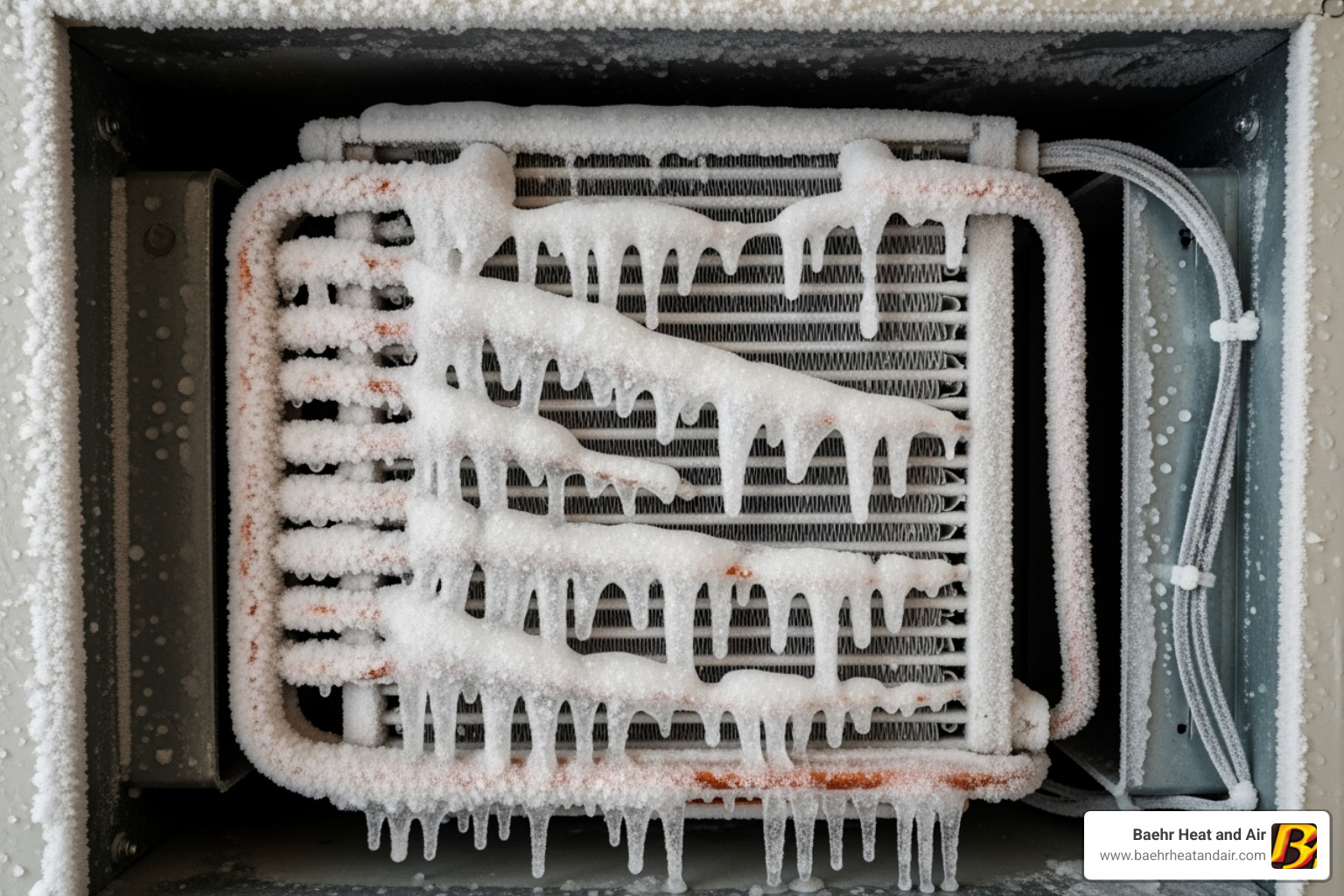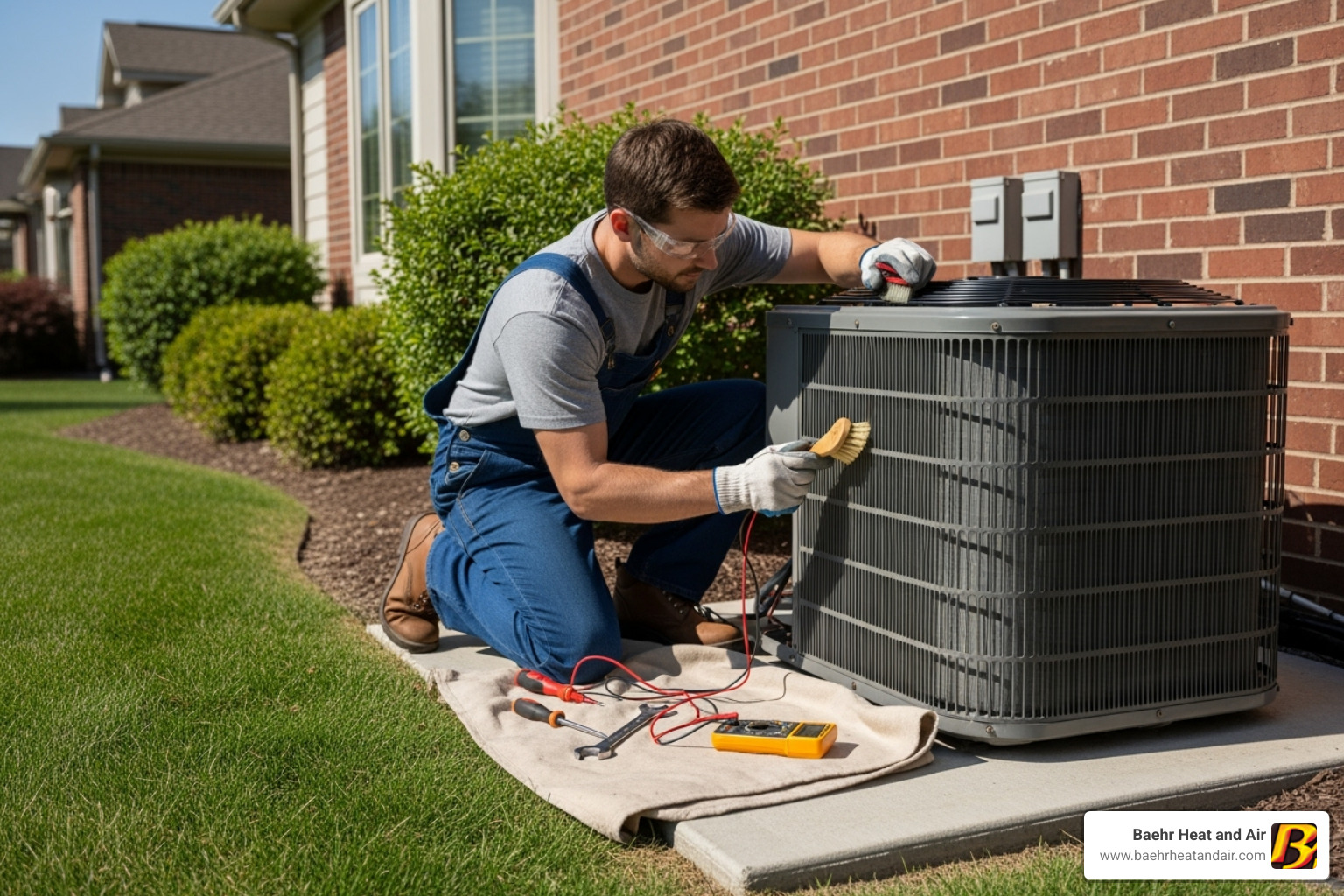Why Your AC Stops Working When You Need It Most
AC not cooling is one of the most frustrating problems homeowners face, especially during hot summer days in Grass Valley. When your air conditioner runs but fails to cool your home, several common issues could be the culprit.
Quick AC Not Cooling Diagnosis:
- Check thermostat settings – Ensure it’s set to “Cool” and fan is on “Auto”
- Replace dirty air filter – Clogged filters block airflow and freeze coils
- Reset tripped circuit breaker – Power issues prevent proper operation
- Clear outdoor unit – Remove debris blocking the condenser
- Look for frozen coils – Turn off AC and let thaw completely
- Listen for unusual sounds – Clicking or buzzing indicates component failure
If your air conditioner is not blowing cold air or is simply not working or turning on, we can help. Save time and money by learning AC fixes you can try yourself.
Most AC cooling problems fall into two categories: simple fixes you can handle yourself and complex issues requiring professional repair. According to industry data, three-quarters of all homes in the US have air conditioners, and most units last between 10 and 15 years with proper maintenance.
The good news? Many cooling problems have straightforward solutions. A dirty air filter, incorrect thermostat setting, or tripped breaker can often be fixed in minutes. However, issues like refrigerant leaks, compressor failure, or electrical problems need expert attention.
Your First Steps: Simple Checks for a Malfunctioning AC
When your home feels more like a sauna than a sanctuary, and your AC not cooling is the pressing issue, don’t panic! Many common problems can be solved with a few simple checks that even a novice homeowner can perform. These initial steps can save you time, money, and the frustration of waiting for a professional when the fix is just a flick of a switch away.
Is Your Thermostat the Culprit?
It might sound too simple, but often, the problem isn’t with your AC unit itself, but with the command center: your thermostat. We’ve all been there – adjusting the temperature over and over, only to realize the settings were off.
First, check the obvious: Is your thermostat set to “Cool” mode? Sometimes, it might accidentally be on “Heat” or “Fan Only.” If it’s on “Fan Only,” your unit will just circulate air at room temperature, which can feel warm, especially if you’re expecting a blast of cold air. Ensure the desired temperature is set lower than the current room temperature. If your thermostat has batteries, a blank screen or unresponsive buttons might mean it’s time for a fresh set.
Next, consider the fan setting. Most thermostats have “AUTO” and “ON” options. We recommend setting your fan to “AUTO.” In this setting, the fan runs only when the cooling system is actively cooling your home. If it’s set to “ON,” the fan will run continuously, even when the compressor isn’t engaged, blowing uncooled air. While this might feel like airflow, it won’t be cold, and it can actually increase your energy bill. For more detailed troubleshooting steps, you can explore our guide on How to Troubleshoot an Air Conditioner.
The Easiest Fix: Check Your Air Filter
If your thermostat checks out, the next stop on our troubleshooting journey is usually the air filter. This seemingly small component plays a massive role in your AC’s performance. A dirty or clogged air filter is one of the most common reasons an AC not cooling effectively.
Why is it such a big deal? Your air filter is designed to trap dust, pet dander, and other airborne particles, preventing them from entering your HVAC system and damaging its components. However, over time, these particles accumulate, restricting the airflow that your AC needs to operate efficiently. Imagine trying to breathe through a thick, dusty blanket – that’s what your AC is trying to do with a clogged filter!
This restricted airflow can lead to a cascade of problems. Without proper air moving across the evaporator coils (more on those later!), they can get excessively cold and freeze over. A frozen coil won’t absorb heat, meaning your AC will blow warm air or no air at all. We often see filters that look like fuzzy art projects!
The good news is that replacing your air filter is a simple and inexpensive DIY fix. We recommend checking your air filter monthly and replacing it every 1 to 3 months, or more frequently if you have pets or allergies. Just look at the difference a clean filter makes:
For a comprehensive guide, check out this resource on Air Conditioner Filter Replacement 101.
Have You Checked the Power Supply?
Sometimes, your AC’s problem isn’t mechanical, but electrical. Before you assume the worst, let’s play detective with your power supply.
First, head to your electrical panel. Look for a circuit breaker labeled for your “AC” or “Furnace.” If it’s tripped (usually halfway between “ON” and “OFF”), simply flip it completely to “OFF” and then firmly back to “ON.” This can often resolve the issue. However, if the breaker trips immediately again, do not keep resetting it! This signals a more serious electrical problem that requires professional attention, as repeatedly resetting it could damage your system or even pose a fire hazard.
For central AC units, there’s often a disconnect switch located near your outdoor condenser unit. This looks like a small box mounted on the wall. Make sure the switch inside is in the “ON” position. Sometimes, it might have been accidentally switched off, or a fuse inside might have blown. Some outdoor units also have a plug – ensure it’s securely connected and check for any visible damage to the wiring.
Loss of power to the outdoor unit means the compressor and condenser fan won’t operate, which are crucial for cooling. Without them, your indoor unit might still blow air, but it won’t be cold. If you suspect electrical connection problems, our guide on Addressing AC Electrical Connection Problems offers further insights.
Common Reasons Your AC is Not Cooling
When those basic troubleshooting steps don’t solve your AC not cooling problem, it’s time to look deeper. The good news? Understanding these more complex issues can help you spot problems early and know when it’s time to call in the pros.
Your air conditioning system is essentially a heat-moving machine, and when any part of that process breaks down, you’ll feel it immediately. Let’s explore the most common culprits that prevent your AC from delivering that blessed cool air.
Dirty or Frozen Coils: A Major Airflow Blocker
Your AC has two sets of coils working together like dance partners – when one stumbles, the whole performance suffers. These coils are where the actual cooling happens, so keeping them clean and ice-free is crucial for proper operation.
The dirty evaporator coil lives inside your home, usually tucked away in your furnace or air handler. This coil is where warm air from your house meets the cold refrigerant, creating that wonderful cooling effect. Over time, even with a good filter, dust and grime can coat these coils like a blanket. When that happens, the coil can’t absorb heat effectively, leaving you with lukewarm air instead of the arctic blast you’re craving.
Outside, your dirty condenser coil faces an even tougher battle. Pollen, leaves, grass clippings, and everyday dirt can turn this heat-releasing powerhouse into a clogged mess. We’ve seen outdoor coils so packed with debris, they look like they’re growing their own garden! When the condenser coil can’t release heat properly, your entire system struggles to cool your home.
But here’s where things get really frustrating: frozen evaporator coils. Yes, you read that right – your cooling system can literally freeze itself into uselessness.
When airflow gets restricted (usually from that dirty filter we talked about earlier), the evaporator coil gets too cold and ice starts forming. Once ice builds up, no air can pass through, and your AC not cooling becomes your AC not working at all.
If you find frozen coils, resist the urge to grab an ice pick! Turn off your entire system and let it thaw naturally – this can take several hours. While you wait, replace that air filter and make sure all your vents are open. Once everything’s thawed, you can try restarting. If the ice returns, you’ll need professional help to find the root cause. Our detailed guide on Why Is Your AC System Freezing Up? can help you understand this tricky problem better.
The Role of Refrigerant in an AC Not Cooling
Think of refrigerant as your AC’s secret sauce – without enough of it, even the most expensive system becomes an oversized fan. This chemical compound works tirelessly, cycling between liquid and gas states to absorb heat from inside your home and dump it outside.
Here’s the thing about refrigerant: unlike gas in your car, it doesn’t get “used up.” Your AC is a sealed system, so if refrigerant levels are low, there’s almost certainly a leak somewhere. And leaks mean trouble.
Low refrigerant creates a domino effect of problems. Your system can’t absorb enough heat, so it runs longer trying to reach your desired temperature. The evaporator coil might freeze because there’s not enough refrigerant flowing through it. Meanwhile, your energy bills climb as your poor AC works overtime for mediocre results.
You might hear hissing sounds or bubbling noises – these are often refrigerant trying to escape through a crack or loose connection. Sometimes you’ll notice ice forming on the refrigerant lines, which looks alarming but is actually a symptom of the system running too cold due to low refrigerant levels.
Refrigerant is serious business. It’s not something you want to mess with yourself – it requires special handling, proper disposal, and precise measurements. Only certified technicians should work with Refrigerant systems. If you suspect a leak, turn off your system and call for professional help. For more detailed information about detection and repair, check out this resource on AC Refrigerant Leak Detection and Repair.
Outdoor Unit Problems: The Condenser
Your outdoor unit might look like it’s just sitting there, but it’s actually working incredibly hard to dump all the heat it pulled from your house. When problems strike this hardworking component, your AC not cooling becomes the least of your worries.
The most common issue we see is a blocked condenser unit. Nature loves to reclaim outdoor equipment! Weeds grow up around it, leaves pile against it, and grass clippings from weekend mowing get sucked right into the coils. Your condenser needs breathing room – at least two feet of clear space all around – to move air efficiently.
We always tell our customers: treat your outdoor unit like it has personal space issues. Keep plants trimmed back, clear away debris regularly, and give it a gentle rinse with your garden hose occasionally (with the power off, of course). A clean condenser is a happy condenser.
But sometimes the problem isn’t what’s around the unit – it’s what’s inside it. The condenser fan motor is responsible for pulling air through those coils to carry heat away. When this fan stops working, heat gets trapped, and your refrigerant can’t cool down properly.
You might hear the outdoor unit humming but notice the big fan on top isn’t spinning. This often points to a faulty capacitor – a small but crucial part that gives the motor the electrical boost it needs to start. Without it, the motor just sits there humming sadly while your house gets warmer.
If you notice your condenser fan isn’t running, shut off power to the unit immediately. Continuing to run without proper airflow can damage expensive components. For a comprehensive look at outdoor unit problems, our guide on Troubleshooting AC Condenser Issues covers everything you need to know.
When to Call a Professional: Advanced AC Problems
Let’s be honest – we love empowering homeowners to fix simple problems themselves. There’s nothing quite like that “I did it!” feeling when you solve an issue on your own. But when your AC not cooling problem goes beyond the basics, it’s time to wave the white flag and call in the professionals.
Think of it this way: you might change your own oil, but you probably wouldn’t rebuild your car’s engine in your driveway. The same logic applies to your air conditioning system. Some issues require specialized tools, safety training, and years of experience to diagnose and repair safely.
Trying to tackle complex AC problems yourself can turn a manageable repair into a costly disaster. We’ve seen well-meaning homeowners accidentally damage expensive components or, worse, put themselves in danger with electrical issues. When you’re dealing with high-voltage electricity, pressurized refrigerant systems, and intricate mechanical components, professional expertise isn’t just helpful – it’s essential.
If you’re wondering whether your situation calls for expert help, our guide on how to Identify the Need for AC Repair can point you in the right direction.
Signs of a Failing Compressor or Electrical Fault
Your AC’s compressor is like the heart of the entire cooling system. Just as your heart pumps blood throughout your body, the compressor circulates refrigerant through your AC system, creating the pressure changes that make cooling possible. When this vital component starts failing, your AC not cooling becomes inevitable.
Compressor trouble often announces itself in dramatic ways. You might hear grinding, rattling, or clanking sounds coming from your outdoor unit that sound like a blender full of marbles. Sometimes the outdoor unit won’t run at all, or you’ll notice only the fan spinning while the compressor sits silent. If your circuit breaker keeps tripping every time you try to run the AC, that’s another red flag pointing to compressor problems.
The frustrating thing about compressor failure is that your indoor unit might seem perfectly fine – the fan runs, air blows through the vents – but that air feels like it’s coming straight from outside rather than being cooled. Unfortunately, compressor repairs are complex and expensive, often requiring you to weigh repair costs against replacement.
Electrical faults can be even trickier because they’re invisible until something goes wrong. You can reset a tripped breaker yourself, but deeper electrical issues require professional diagnosis and repair.
Take the capacitor, for instance. This small, cylindrical component stores electrical energy and provides the initial jolt needed to start your compressor and fan motors. When it fails, you might hear clicking sounds from your outdoor unit followed by… nothing. Or perhaps a persistent buzzing noise while the fan refuses to spin. Here’s the crucial part: even when your power is turned off, capacitors can store dangerous electrical charges. Attempting to replace one yourself could result in a serious shock.
Then there’s the contactor – essentially an electrical switch that sends power to your outdoor unit’s components. When it malfunctions, your outdoor unit becomes like a car with a dead ignition switch. Everything might look fine, but nothing happens when you try to start it.
Wiring problems add another layer of complexity. Corroded connections, damaged wires, or loose terminals can cause intermittent failures that are maddening to diagnose. One day your AC works fine, the next it doesn’t, and you’re left scratching your head.
These electrical components work together in a delicate dance, and troubleshooting them safely requires specialized knowledge and equipment. Our detailed guide on Troubleshooting AC Capacitor Failure explains why professional intervention is so important for these issues.
Leaky Ductwork and Undersized Units
Sometimes the problem isn’t with your AC unit at all – it’s with how the cooled air gets to you or whether your system is the right size for your home in the first place.
Leaky ductwork is like having holes in your garden hose. Your AC might be producing perfectly cold air, but if that air is escaping into your attic, crawl space, or wall cavities before it reaches your living areas, you’ll never feel comfortable. We’ve seen cases where homeowners were losing 30% or more of their cooled air through duct leaks!
This creates a frustrating cycle: your AC not cooling effectively leads to longer run times, which drives up your energy bills while still leaving you hot and uncomfortable. You might notice some rooms that never seem to get cool, or hot spots that persist no matter how low you set the thermostat. Poor indoor air quality can also result when duct leaks pull dust, allergens, and humid air into your system.
Sealing ductwork properly requires specialized equipment like duct blasters to measure airflow and professional-grade sealants that can withstand temperature changes and vibration over time. It’s not a job for duct tape, despite what the name suggests! For comprehensive information about this issue, check out our resource on Addressing AC Ductwork Leakage Issues.
An undersized AC unit presents a different challenge entirely. Imagine trying to cool a mansion with a window unit – it’s just not going to happen! Your AC system needs to be properly matched to your home’s size, insulation levels, window efficiency, ceiling height, and local climate conditions.
When your unit is too small, it becomes like a marathon runner who’s constantly sprinting. The system runs almost continuously, struggling to reach your desired temperature and never quite getting there. You’ll notice high humidity levels even when the AC runs, because the system doesn’t operate long enough in each cycle to effectively remove moisture from the air.
On those really hot summer days in Grass Valley, an undersized unit will simply give up trying to keep up with the heat load. Your home never feels truly comfortable, and the constant operation wears out components much faster than normal, leading to premature breakdowns and higher energy costs.
Determining the correct size for an AC replacement involves complex calculations that factor in your home’s unique characteristics. It’s not just about square footage – professionals use detailed load calculations to ensure your new system will keep you comfortable efficiently for years to come.
The Best Fix: How Regular Maintenance Prevents Breakdowns
We’ve explored many reasons why your AC not cooling might be an issue. While troubleshooting can help identify immediate problems, the ultimate “fix” for many of these issues is proactive, consistent maintenance. Think of your AC like your car – it needs regular tune-ups to run efficiently and prevent major breakdowns.
Here’s something that might surprise you: most of the AC not cooling problems we’ve discussed today could have been prevented with regular maintenance. That dirty coil that’s blocking airflow? A professional cleaning would have caught that. The refrigerant leak that’s leaving you sweating? We would have spotted the early warning signs during a routine inspection.
Regular AC maintenance isn’t just about avoiding emergencies – it’s about optimizing performance, extending your system’s lifespan (most AC units last between 10 and 15 years, but some can go 15-20 with excellent care!), and ensuring energy efficiency. Plus, it keeps your manufacturer’s warranty valid, which can save you thousands if something major goes wrong.
What’s Included in a Professional AC Tune-Up?
When our skilled technicians at Baehr Heat and Air perform an AC tune-up, we don’t just take a quick peek and call it good. We roll up our sleeves and give your system the thorough attention it deserves.
Coil cleaning is one of the most important services we provide. We thoroughly clean both your indoor evaporator coils and outdoor condenser coils to ensure maximum heat transfer. Remember those dirty coils we talked about earlier? This is how we prevent them from becoming a problem in the first place.
Our refrigerant check involves verifying levels and inspecting for any signs of leaks, ensuring your system has exactly the right amount of refrigerant. Too little, and you get warm air. Too much, and your system works inefficiently and can even be damaged.
We also perform a comprehensive electrical connection inspection, checking and tightening all connections while looking for corrosion or wear that could lead to those frustrating electrical faults. Loose connections don’t just cause performance problems – they can be dangerous.
Drain line cleaning prevents those messy water leaks that can damage your home, while motor lubrication keeps all moving parts running smoothly, reducing friction and preventing premature wear. Finally, our system calibration ensures your thermostat, fan operation, and overall system performance meet manufacturer specifications.
This detailed attention helps us catch minor issues before they escalate into major, expensive repairs. A professional AC Tune-Up Can Prevent Breakdowns and save you countless headaches during peak cooling season.
Why an Ounce of Prevention is Worth a Pound of Cure
You’ve probably heard this old saying, but when it comes to your AC system, it couldn’t be more true. Choosing regular AC maintenance is honestly one of the smartest investments you can make for your home comfort and your wallet.
Avoiding costly repairs is the big one. Many of those “advanced” problems we discussed – compressor failure, major electrical issues, severe coil damage – start as small, easily detectable issues during routine maintenance. We can’t tell you how many times we’ve prevented a $300 repair from turning into a $3,000 system replacement, simply because we caught the problem early.
Your indoor air quality improves dramatically with a well-maintained system. Clean filters and coils mean cleaner air circulating through your home, reducing allergens and pollutants that can trigger asthma and allergies. It’s amazing how much better families feel when their AC system is properly maintained.
Lower energy bills are another immediate benefit. A clean, well-tuned AC unit operates more efficiently, using less energy to cool your home. This translates directly to lower monthly utility bills, often paying for the maintenance service within the first year.
Extending your AC’s lifespan is where the real value shines. Just like regular oil changes extend the life of your car, consistent maintenance extends the life of your AC unit. By keeping components clean and properly lubricated, you reduce wear and tear, helping your system reach or even exceed its average lifespan.
Don’t forget about maintaining warranty validity – many manufacturers require proof of annual professional maintenance to keep your warranty valid. Skipping tune-ups could void your warranty, leaving you responsible for expensive repairs that should have been covered.
We truly believe in the power of proactive care because we’ve seen the difference it makes in our customers’ homes year after year. For more insights on why this approach is so effective, check out Why Regular AC Service is Essential.
Frequently Asked Questions about an AC Not Cooling
When your air conditioner isn’t keeping you cool, it’s natural to have questions – and we’ve heard them all! Over the years at Baehr Heat and Air, we’ve noticed the same concerns pop up again and again. Let’s tackle the most common questions about AC not cooling issues, so you can better understand what’s happening with your system and when to take action.
What happens if I run my AC when it’s not cooling properly?
This is one of the most important questions we get, and honestly, it’s a bit like asking what happens if you keep driving your car when the engine is overheating. Nothing good!
When your AC not cooling properly and you keep it running anyway, you’re essentially forcing a sick system to work overtime. Your unit will desperately try to reach that temperature you’ve set on the thermostat, running constantly and consuming massive amounts of electricity in the process. We’ve seen homeowners’ energy bills double or even triple during these situations.
But the real danger lies in what’s happening to your equipment. That minor issue causing the cooling problem – maybe a small refrigerant leak or slightly dirty coils – can quickly snowball into something much more serious. Further component damage is almost inevitable when you force a struggling system to keep working. Your compressor, which is essentially the heart of your AC, can burn out completely from the extra strain.
The financial impact can be devastating. What might have been a simple, affordable repair can transform into a costly replacement of major components or even your entire system. We’ve seen homeowners turn a $200 coil cleaning into a $3,000 compressor replacement simply because they kept running their AC when it wasn’t cooling properly.
Our advice? If your AC isn’t cooling, turn it off and give us a call. Your wallet will thank you later. For more warning signs to watch for, check out Warning Signs AC System About to Fail.
How do I know if my AC unit is the wrong size for my home?
Size matters when it comes to air conditioners – but bigger isn’t always better! An improperly sized unit is a common culprit behind AC not cooling effectively, and the signs are usually pretty obvious once you know what to look for.
The most telling sign is an AC that runs constantly but never quite gets your home comfortable. It’s like trying to fill a swimming pool with a garden hose – technically possible, but it’s going to take forever and use a lot of resources. During those scorching summer days here in Grass Valley, an undersized unit will run from morning until night, desperately trying to keep up but never quite succeeding.
You’ll also notice high humidity levels throughout your home. A properly sized AC doesn’t just cool the air – it removes moisture too. If your home feels sticky and clammy even when the AC is running, that’s a red flag. Some of our customers describe it as feeling like they’re living in a greenhouse rather than a comfortable home.
Uneven temperatures are another dead giveaway. You might find that your living room is reasonably cool while your bedrooms remain uncomfortably warm. While this can also indicate ductwork problems, an undersized unit often contributes to these hot spots because it simply can’t move enough conditioned air throughout your entire home.
The solution isn’t just buying a bigger unit, though. Proper sizing requires professional calculations that factor in your home’s square footage, insulation quality, window types, ceiling height, and even which direction your home faces. It’s a science, not a guessing game. If you suspect sizing issues, our article AC Might Struggle to Cool Home provides more insights.
Why is my AC blowing warm or hot air?
This is probably the most frustrating symptom of AC not cooling – when your system is clearly running, but instead of that refreshing blast of cold air, you get something that feels like a hair dryer! Don’t worry; you’re not alone, and there are several common explanations.
Sometimes the simplest answer is the right one. Incorrect thermostat settings cause more warm air complaints than you might think. We’ve had service calls where the thermostat was accidentally set to “Heat” instead of “Cool,” or the fan was set to “ON” instead of “AUTO.” It sounds obvious, but when you’re hot and frustrated, it’s easy to overlook the basics.
A clogged air filter is another frequent offender. When your filter gets packed with dust and debris, it chokes off the airflow your system needs. This causes the evaporator coil to get too cold and freeze over. Ironically, a frozen coil can’t absorb heat, so your AC ends up blowing warm air. It’s like trying to cool down by wrapping yourself in a frozen blanket – counterproductive!
Refrigerant leaks are more serious and require professional attention. Without enough refrigerant, your system simply can’t absorb heat from your indoor air. You might hear strange hissing or bubbling sounds coming from your unit – that’s often the refrigerant escaping.
Your outdoor unit plays a crucial role too. If the condenser coil is buried under dirt, leaves, or grass clippings, it can’t release heat effectively. Similarly, if the condenser fan isn’t spinning (often due to a bad capacitor or motor), heat gets trapped in the system, and warm air is all you’ll get indoors.
The most serious cause is compressor failure. The compressor is responsible for pressurizing and circulating refrigerant throughout your system. When it fails, the entire cooling process breaks down. This typically requires professional diagnosis and repair.
For a comprehensive look at this frustrating problem, our detailed guide Why Is Your AC Blowing Hot Air? walks through each possibility and what you can do about it.
Your Local Experts for Lasting Home Comfort
When your AC not cooling transforms your peaceful sanctuary into an uncomfortable furnace, the frustration is real – and we completely understand. Throughout this guide, we’ve explored the journey from simple fixes you can tackle yourself (like swapping out that dusty air filter or flipping a tripped breaker) to the more complex mysteries that require a trained professional’s eye, such as refrigerant leaks or failing compressors.
Here’s what we’ve learned: while DIY troubleshooting can be incredibly empowering and save you both time and money, recognizing when to call in the cavalry is equally important. Think of it like knowing when to change your car’s oil versus when to let a mechanic handle transmission problems. The consequences of pushing forward with a struggling system, skipping regular professional maintenance, or attempting repairs beyond your expertise can be costly – we’re talking about further damage, expensive emergency repairs, and a system that gives up the ghost years before it should.
At Baehr Heat and Air, we’ve built our reputation on delivering outstanding, clear customer experiences with state-of-the-art solutions that actually work. Our focus isn’t just on fixing what’s broken – it’s about building quality, trust, and finding ways to save our customers money while ensuring lasting home comfort. Whether you’re sweating it out in Grass Valley, dealing with the heat in Nevada City, or feeling the temperature rise in North Auburn, our experienced team understands the unique challenges of keeping your home comfortable in our California climate.
We believe in empowering our customers with knowledge (hence this comprehensive guide!), but we also know that sometimes you need a professional diagnosis to get to the root of the problem. We’re not just patching up your AC for a quick fix – we’re invested in your long-term comfort and peace of mind.
Don’t let a stubborn, AC not cooling problem steal another day of comfort from your home. Schedule your AC maintenance in Auburn, CA or give us a call today. Let’s work together to get you back to that blissful feeling of walking into a perfectly cool home after a hot day.
